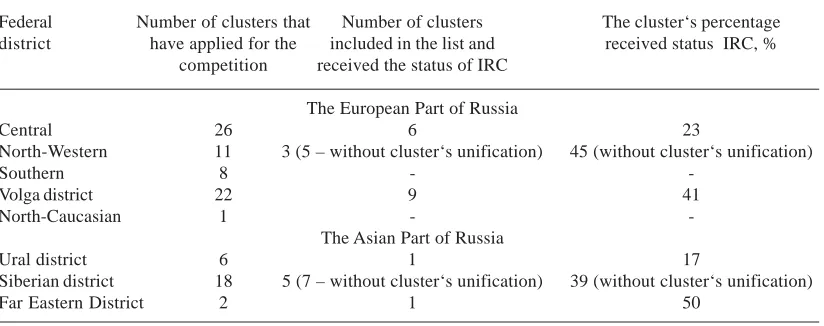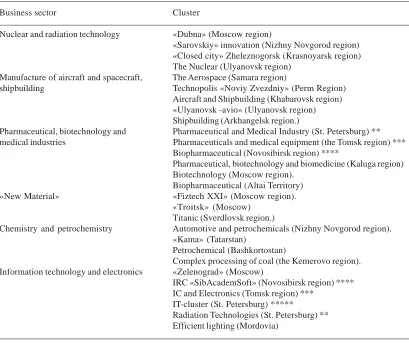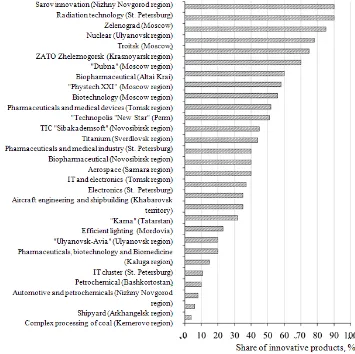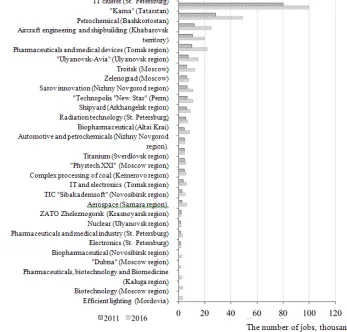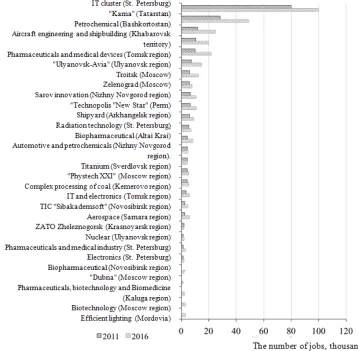* To whom all correspondence should be addressed.
Evaluation and Prospects of the Cluster Model of
Industrial Development
Arsen Azidovich Tatuev1, Alim Beslanovich Nagoev2,
Anzor Hasanbievich Zhankaziev2, Violetta Valerievna Rokotyanskaya3
and Lubov Viktorovna Bondarenko4
1Russian Academy of National Economy and Public Administration Presidente Russian Federation, Russia, 357502, Stavropol region, Pyatigorsk, Dunaevsky st., 5.
2Kabardino-Balkarian State University Named After Kh.M. Berbekov, Russia, 360004, Kabardino-Balkarian Republic, Nalchik, Chernyshevskogo st., 173.
3Moscow State University of Food Production, Russia, 125080, Moscow, Volokolamskoye sh., 11. 4Don State Technical University, Russia, 346500, Rostov Region, Shakhty, Shevchenko st., 147.
doi: http://dx.doi.org/10.13005/bbra/2238
(Received: 18 June 2015; accepted: 13 August 2015)
The contradictions of Russian industrial development are caused the increasing attention to the new forms of economic and organizational principles of sector‘s administration. In that same context the actuality of industrial clustering is growing up. The main goal of the research is overall evaluating the effectiveness of the clustering process of Russian industry, in consideration of regional and industry characteristics.The results show that the clustering process has been actively developing in the national industrial sector, which focused on cooperating of small, medium and large enterprises to implement particular R&D and manufacturing chains. To a certain extent the goal of achieving synergy effects which realize by increasing of economic efficiency and effectiveness of each company or organization due to their high degree of concentration and cooperation, geographical and sectoral variability, innovative activity of organizations which belong to clusters.
Key words: Industry, Clusters, Production innovativeness, Industrial policy.
The transformation processes in the social economic development of modern society are becoming a significant challenge for the national economy‘s industrial sector. It requires new organizational and economic forms of industrial progress, which are sufficient for market requirements and strategic priorities of social development and the requirements of competitiveness as well.
The views of competitiveness in the scientific community have been historically developing from the cost-savings principle through
the resources provision to knowledge and intellectual potential of society (Astakhov & Dobrova, 2012).
The effective utilization of limited resources and intellectual capacity is currently associated with clustering development. The introduction and popularization of the definition «cluster» usually relates to Porter‘s interpretation of geographically concentrated group of related industrial facilities and associated non-profit organizations and institutions in particular areas, which will not only compete, but complement each other (Porter, 2010).
2013), and as a form of management of industrial enterprises (Zhdanova, 2008)
Nowadays, it increasingly emphasizes that the cluster structure is different from such features which are typical for network companies. There are allocated self-organizing principle, stable and flexible relationship, the effective specialization of production activities, distribution of outsourcing cooperation, the organisation of the public economic interests, goals, corporate culture (Izmailova, 2013; Degtyareev, 2009; Ivanova, 2012). According to the new institutional theory, cluster is a hybrid form of institutional relations (Golovanova & Avdasheva, 2010). The most common is that the institutions of business, government and science are considered as the main actors of cluster (Dronova, 2013).
The doctrine of “open innovation” is kindled scientific interest when the research and development activities are actively involved to create a sustainable business model (Avdushkin, 2013).
By the way it is emphasized that the inter-organizational network is a specific contractual arrangements between the formally independent market participants in order to optimum employment of resources, especially knowledge in explicit and implicit forms (Zhokov & Pospelova, 2015). It draws attention to the principles of cluster implementation in cooperation and specialization. The exact figure of clusters in the Russian economy is yet to be determined. So that such form of industrial integration, despite of having significant number of fundamental research is still lacking a clear list of criteria on the basis of which a specific manufacturing agglomeration can be categorized as clusters (Rastvortseva & Cherepovskaya, 2013). At the same time the extent of spread of this phenomenon in the economic complex of Russia can be evaluated by indirect way.
Thus, within the framework of the Working Group which is responsible for development of public-private partnerships in innovation sphere of Government Commission on High Technology and Innovation competitive selection of innovative programs for the development of territorial clusters was held in the early 2012. There was the total number of 94 applications from different federal subject.
However, during the expert evaluation from the representatives of government, scientific, educational organizations and leading companies, only 25 were selected as innovative regional clusters (IRC). This list was approved by the Government of the Russian Federation, where the innovative regional cluster is a set of enterprises and organizations which are allocated in a limited area (cluster members), which are characterized by the presence of (13) :
• Bringing together the members of R&D and manufacturing chain in one or more sectors (main economic industries);
• Mechanism of coordination and
cooperation of cluster members;
• A synergistic effect in terms of improving economic efficiency and effectiveness of each company or organization due to their high degree of concentration and cooperation.
In general, the classification of the cluster‘s types can be performed on several criteria (Mirolubova, Karlina & Kovaleva, 2013; Kutsenko, 2009; Bareev, 2012): regional, national, transnational, symmetric, asymmetric, export-oriented, etc.
METHOD
The basic methods of statistical analysis are to group data by criteria areas, industries, number of organizations, innovative production, number of jobs and the productivity of workers.
RESULTS
The analysis of the distribution of innovative regional clusters according to the federal districts of Russia
region); five clusters - in the Siberian Federal District
There were about 70 percent of the clusters which have applied for participation in the competition in these three federal districts. The minimum number îf applications have been submitted from the North-Caucasian and the Far Eastern Federal Districts - 1 and 2, respectively, and the Central Federal District got 26 applications. The Volga district got 22 applications. The Siberian district got 18 applications. The total number of clusters from the Siberian Federal District which have applied for participation in the competition, just 39% passed the competitive selection and got the status of innovative regional clusters (IRC). In the Volga Federal District - 41%, and in the Central - only 23%
The distribution of experimental innovative regional clusters of industry areas
In total, 49 clusters of regions took part in the competition. The largest number of applications were received from the Moscow region and St. Petersburg, Voronezh, Novosibirsk, Kemerovo, Rostov and Sverdlovsk regions, the Republic of Bashkortostan, it allows to draw the conclusions about the level of development of these integration formations in the Russian economy
The Table 2 provides the information on the distribution of experimental innovative regional clusters of industry areas in 2013.
The chart shows that in accordance to industry-specific cluster formations in the
framework of the competition were formed six industrial areas, «Nuclear and Radiation Technology»; «Manufacture of aircraft and spacecraft, shipbuilding»; «Pharmaceutical, biotechnology and medical industry»; «New materials»; «Chemistry and petro chemistry»; «Information Technologies and Electronics». The largest number of clusters that have passed the competitive selection refer to such industry areas as «Information Technologies and Electronics» and «Pharmaceutical, biotechnology and medical industry» - 7 and 6, respectively.
By the way these two clusters – «Innovation Cluster of information and biopharmaceutical technologies of Novosibirsk Region» and «Pharmaceuticals, medical technology and information technology of Tomsk region» had a mixed - interdisciplinary character. The clusters of Tatarstan and Bashkortostan republics, Arkhangelsk, Kemerovo and Nizhny Novgorod regions, the Khabarovsk Territory are characterized by the leading role of large-scale industrial production. The development of these clusters favors the accelerated transfer of innovations in direct production, and the creation of value added tax for the new small and medium enterprises
In contrast, the clusters of Pushchino, Troitsk and Dimitrovgrad, «Fiztech-XXI» the main priority is to use the potential of leading scientific and educational organizations within their territories. It considers an intensification of the process of attracting foreign advanced
Table 1. The distribution of innovative regional clusters by the federal districts in 2013 *
Federal Number of clusters that Number of clusters The cluster‘s percentage district have applied for the included in the list and received status IRC, %
competition received the status of IRC
The European Part of Russia
Central 26 6 23
North-Western 11 3 (5 – without cluster‘s unification) 45 (without cluster‘s unification)
Southern 8 -
-Volga district 22 9 41
North-Caucasian 1 -
-The Asian Part of Russia
Ural district 6 1 17
Siberian district 18 5 (7 – without cluster‘s unification) 39 (without cluster‘s unification)
Far Eastern District 2 1 50
Table 2. The distribution of experimental innovative regional clusters of industry areas in 2013. *
Business sector Cluster
Nuclear and radiation technology «Dubna» (Moscow region)
«Sarovskiy» innovation (Nizhny Novgorod region) «Closed city» Zheleznogorsk (Krasnoyarsk region) The Nuclear (Ulyanovsk region)
Manufacture of aircraft and spacecraft, The Aerospace (Samara region)
shipbuilding Technopolis «Noviy Zvezdniy» (Perm Region) Aircraft and Shipbuilding (Khabarovsk region) «Ulyanovsk -avio» (Ulyanovsk region) Shipbuilding (Arkhangelsk region.)
Pharmaceutical, biotechnology and Pharmaceutical and Medical Industry (St. Petersburg) ** medical industries Pharmaceuticals and medical equipment (the Tomsk region) ***
Biopharmaceutical (Novosibirsk region) ****
Pharmaceutical, biotechnology and biomedicine (Kaluga region) Biotechnology (Moscow region).
Biopharmaceutical (Altai Territory) «New Material» «Fiztech XXI» (Moscow region).
«Troitsk» (Moscow) Titanic (Sverdlovsk region.)
Chemistry and petrochemistry Automotive and petrochemicals (Nizhny Novgorod region). «Kama» (Tatarstan)
Petrochemical (Bashkortostan)
Complex processing of coal (the Kemerovo region). Information technology and electronics «Zelenograd» (Moscow)
IRC «SibAcademSoft» (Novosibirsk region) **** IC and Electronics (Tomsk region) ***
IT-cluster (St. Petersburg) *****
Radiation Technologies (St. Petersburg) ** Efficient lighting (Mordovia)
* The chart is based on (Gokhberg & Shadrina, 2013)
** Clustered medical, pharmaceuticals, radiation technologies St. Petersburg
*** Clustered "Pharmaceuticals, medical technology and information technology Tomsk Oblast"
**** Combined in innovative biopharmaceutical cluster of information and technologies of the Novosibirsk Region ***** Clustered "The development of information technology, electronics, instrumentation, communications, and information and telecommunications St. Petersburg"
manufacturing lines and their deployment on the basis of existing scientific and human capacity and the development of small and medium-sized innovative entrepreneurship in the process of commercialization of innovations.
The analysis of the participants of innovative regional clusters by federal districts
There is a diagram which shows the information about number of participants of innovative regional clusters according to the federal districts in 2013 on the Figure 1. The diagram shows that the great number of participants of innovative regional clusters are in the regions which are leaders in the number of innovative regional clusters - Volga (122), Central (107) and
Fig. 1. The number of participants of innovative regional clusters according to the federal districts in 2013; the number of organizations (figure is based on: Innovative regional clusters // Innovations in Russia. – URL: http:/ /innovation.gov.ru/taxonomy/term/545)
Fig. 2. The share of innovative goods, works and services to the output, which were made by participants of the experimental innovative regional clusters in 2012,% (figure is based on (Gokhberg & Shadrina, 2013))
Fig. 3. The number of job positions of the members of the experimental innovative regional clusters with salary twice as high as average rate in the region of the cluster, thousand. Job positions (figure is based on (Gokhberg & Shadrina, 2013))
At the same time almost all members which passed the competitive selection of clusters are located in areas with a high concentration of scientific, technical and industrial activity. Among them, for example, the number of science cities, special economic zones and closed administrative-territorial entities, including Zelenograd, Dubna, Pushchino, Obninsk, Troitsk, Sarov, Zheleznogorsk, Dimitrovgrad; agglomeration of Moscow, St. Petersburg, Novosibirsk, Nizhny Novgorod, Samara, Tomsk, Perm, Ulyanovsk, Nizhnekamsk; the territory as part of the Khabarovsk and Altai territories, the Arkhangelsk Region, the Republic of Mordovia and Bashkortostan.
To evaluate the current level of innovative activity of the participants of innovative
regional clusters, which passed the competitive selection the share of innovative goods, works and services to the output was used. There is a diagram on the Figure 2 which shows the estimated value of this indicator of the participating organizations experimental innovative regional clusters in 2012.
The maximum value of this indicator recorded in clusters which are attributable to the sector «Nuclear and Radiation Technology» (over 60%). Relatively the high rates are in clusters of industries such as «New Materials» and «Life Sciences and medical industry» (40%). And the lowest rates are in clusters of industry «Chemistry and petrochemistry».
Fig. 4. The volume of output per worker in the organization - participants of innovative experimental regional clusters, thousands. rub./person. per year (graph is based on (Gokhberg & Shadrina, 2013))
(Nizhniy Novgorod region.), Radiation Technology (St. Petersburg), «Zelenograd» (Moscow), nuclear (Ulyanovsk region.) «Troitsk» (Moscow), but Zheleznogorsk (Krasnoyarsk Territory), the share of innovative goods, works and services to the output was at the level of 70-90%. The share of innovative products in the clusters «Dubna» (Moscow reg.) Biopharmaceuticals (Altai region), «Fiztech XXI» (Moscow reg.), Biotechnology (Moscow reg.), Pharmaceuticals and Medical Appliances (Tomsk region.), Technopolis «New Star» (Perm Territory), CTI «SibAcademSoft» (Novosibirsk region.), titanium (Sverdlovsk region.), Pharmaceutical and Medical Industry (St. Petersburg) Biopharmaceuticals (Novosibirsk region.) was at the level of 40-60%.
The share of innovative products in the Aerospace cluster (Samara reg.), IT and Electronics
in the region of the cluster. In general, in the cluster members organizations the number of jobs with a salary twice as high as average rate in the region of the cluster was 179.6 thousand. And this figure should increase by 84.7% - to 331.7 thousand by 2016.
In general, the chart shows that the IT cluster (St. Petersburg), the number of job positions with a salary twice as high as average rate was 80 thousand in the region based cluster in 2011. And their number should be increased to one hundred thousand by 2016. In the cluster «Kama» (Tatarstan) - in 2011 - about thirty thousand jobs with a salary twice as high as average rate the region based cluster, and they will plan to increase up to 50 thousand by 2016. The number of jobs with a salary twice as high as average rate in the region-based cluster was ranged from 10 to 15 thousand in 2011 in such clusters as the Aircraft and Shipbuilding (Khabarovsk Territory), Pharmaceutical and Medical Industry (St. Petersburg), «Ulyanovsk-Avia» (Ulyanovsk region.)., and they will increase it up to 20-50 thousand. The rest of clusters that have passed the competitive selection the number of jobs with a salary twice as high as average rate of its region-based cluster, was less than 10 thousand, and in total - about 80 thousand. At the same time it is planned to double such jobs for the most part of the clusters which were presented in 2016 and then the total number should exceed 140-150 thousand. By the way, the development of innovative regional clusters which include the modernization of the industrial and technological base, commercialization of new products and the expanding of cooperation, should lead to the productivity increasing. There is a diagram on Figure 4 which illustrates the performance of volume output per worker in the organizations-participates of the experimental innovative regional clusters.
So, in the petrochemical (Bashkortostan), «Kama» (Tatarstan) and biopharmaceutical (Altai Territory) clusters the volume of production output per worker was at the level of 4.5-7.5 mln in 2011. rubles per person per year, and it should be grown to 6-10 mln. rubles per person per year by 2016. In clusters «Fiztech XXI» (Moscow region)., Pharmaceutical, biotechnology and biomedicine (Kaluga reg.), Automotive and Chemicals (Nizhny
Novgorod region.), Titanium (Sverdlovsk region.), Pharmaceutical and Medical Industry (St. Petersburg), Integrated processing of coal (the Kemerovo region)., CTI «SibAcademSoft» (Novosibirsk region)., aerospace and shipbuilding (Khabarovsk Territory) the volume of production output per worker was at the level of 2-3.5 mln. rubles per person year in 2011, and it should be increased to 4-5.5 mln. rubles per person per year by 2016.
In clusters Technopolis «New Star» (Perm Territory), Sarov Innovation (Nizhny Novgorod region.), «Dubna» (Moscow region), «Ulyanovsk-Avia» (Ulyanovsk region.), Zheleznogorsk (Krasnoyarsk Territory) Biopharmaceutical (Novosibirsk region.) Shipbuilding (Arkhangelsk region). «Zelenograd» (Moscow), IT and Electronics (Tomsk region) the volume production output per worker in 2011 was at the level of 1-2 mln. rubles per year, and it should be increased to 1.5-3.5 mln. rubles per person per year by 2016. Clusters Biotechnology (Moscow reg.), «Trinity» (Moscow), Radio electronics (St. Petersburg), nuclear (Ulyanovsk region), Aerospace (Samara region), Pharmaceuticals and Medical Appliances (Tomsk region), Effective lighting (Mordovia) Radiation Technologies (St. Petersburg), the IT cluster (St. Petersburg) the volume of production output per worker in 2011 was at the level of 0.5-1 mln. rubles per person per year, it should be increased to 0.7-2 mln. rubles per person per year and by 2016. Generally, almost half of the average volume of the cluster production output per worker in the period from 2011 to 2013 should be increased by half
DISCUSSION
held during the Working Group Activity on the development of public-private partnerships in the innovation sector with the Government Commission on High Technology and Innovation as the geographical and sectoral clusters of variability, as well as indicators of innovation activity of organizations within into clusters.
The development of industrial cluster organization meets the basic requirements of social-economic development and modernization of the national economy, economic security and stability of the national economic system (Edelev & Lyapuntsova, 2014; Borodin, Tatuev, Shash, Lyapuntsova & Rokotyanskaya, 2015; Tatuev & Tatuev, 2015; Rokotyanskaya, 2013).
Therefore, in our opinion, it is advisable in the question of industrial policy to strengthen support for the process of creating vertical industrial clusters uniting similar in principle sectoral industrial production as the core, and vertically integrated with their peripheral businesses. This organizational and economic space of the state can and should play a key functional role in reproduction processes through the mechanism of public-private partnerships.
CONCLUSION
The development of the industrial cluster organization meets the basic requirements of social-economic development and modernization of the national economy, economic security and stability of the national economic system as well. Therefore, it is advisable to strengthen support for the process of creating vertical industrial clusters cooperating similar industrial production in the question of the industrial policy branches and the interlinked economic activities enterprises. In such business concept the government must play lead functional role in economic reproduction process through public-private partnerships mechanism. This organizational and economic space of the state will have to play a key functional role in reproduction processes through the mechanism of public-private partnerships.
REFERENCES
1. Astakhov, A.A. & Dobrova, K.B. Research of development and operation of innovative
Russian industrial corporations. (pp .56-61). MID (Modernization. Innovations. Development), 2012; ¹8.
2. Porter, M. The Competition. Williams 2010. 3. Gasanov, M.A. & Kanov, V. I. Cluster as a
structural institute of competitiveness economy. (pages.13-21).The reporter of Tomsk State University. Economy, 2013; ¹4(24).
4. Zhdanova, O. Cluster as a modern form of industrial enterprises management. The reporter of Economic Institute of RAS, 2008; ¹4. 5. Izmailova, N.M. The imperatives of clustering
manufacture as an objects of economic and theoretical analysis (pp. 26-28). Terra Economicus, 2013; Ò.11, ¹1-2.
6. Degtyareev, A.N. The implementation of the cluster principles in the innovation economy. ( pp. 32-37). Chief Engineer, 2009; ¹9.
7. Ivanova, E.V. Essence and types of cluster (pp. 83-85). Production manager, T.54, 2012; ¹3. 8. Innovative clusters and structural changes in the
Russian economy: the report about RE (conclusion): 09-08-0006 / C.V.Golovanova, C.B.Avdasheva. – M.: State University Higher School of Economics, 2010. – 147 p.
9. Dronova, Y.I. Aspects of organization cluster definition and cluster classification in economy (pp. 33-41). Scientific reports of Belgorod State University. Edition: History. Political science. Economy.Informatics, 2013; 28, ¹22-1(165). 10. Avdushkin, E.F. Open innovations as an element
of the matrix of the new economy (pp. 4-9). Aspects of new economy, 2013; ¹4(28). 11. Zhokov, E.A. & Pospelova , T.V. Conceptual
bases of the necessity of forming a triple helix as the innovative peak performance of the national economy (pp. 24-30). MID (Modernization. Innovations. Development), 2015; ¹1(21).
12. Rastvortseva, S.N. & Cherepovskaya, N.A. Identification and assessment of regional clusters (p.123-133). Regional economy, 2013; ¹4. 13. Order of the Prime Minister of The Russian
Federation. 28th of August 2012ã. ¹ÄÌ-Ï8-5060 «About approving the list of innovative regional clusters» // Ministry of Economic Development of the Russian Federation. – URL: http:// economy.gov.ru/minec/activity/sections/ innovations/politic/doc20120907_02.
14. Mirolubova, T.V., Karlina, T.V. & Kovaleva, T.Y. (2013). Factors of formation and development of regional clusters (pp. 183-189).Perm State University
16. Bareev, T.F. Classification of clusters in modern economics (pp. 57-61). Actual problems of Economy and Law, 2012; ¹3.
17. Experimental innovative territorial clusters in Russia / under the editorship L.M.Gokhberg, A.E.Shadrina. – M.: National Research University «Higher School of Economic», 2013. – pp.20-29.
18. Edelev, D.A. & Lyapuntsova, E.V. Innovative factors of the social-economic development of Russian industry (pp. 250-255). The reporter of North Ossetia State University of C. L. Khetagurov, 2014; ¹ 4.
19. Borodin, A.I., Tatuev, A.A., Shash, N.N.,
Lyapuntsova, E.V. & Rokotyanskaya, V.V. Economic-mathematical model of building a companies potential (pp. 198-205). Asian Social Science, 2015; 11, ¹ 14.
20. Tatuev A.A., & Tatuev, Ask.A. Factors of economic security in industry and business in modern society (pp. 900-903). Economics and Business, 2015; ¹ 6, p.1.
